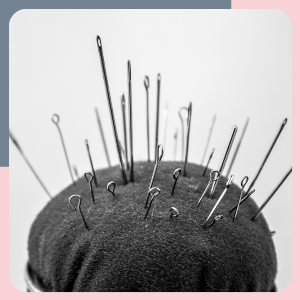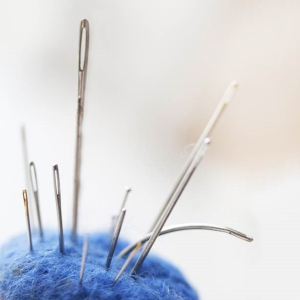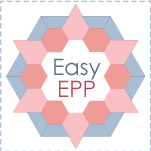6 Essential Needles for Hand Embroidery


Have you been needled about what type of needle should you use in your embroidery projects? Or perhaps, choosing the right type of needle is like looking for a needle in a haystack?
One of the most basic and the most important tool in stitching - and the one we certainly can't live without - is the needle. Choosing the right kind of needle for this or that type of embroidery can make or break the stitching experience and the finished project, so spending just a little bit more time choosing is absolutely necessary.
Needles come in different range and sizes. There are different types of embroidery that require different types of needles. In choosing the right type of needle to use in an embroidery project, there are several factors to consider like the following:
THE SIZE
Remember the golden rule when it comes to needle sizes? The larger the number, the smaller the needle. The type of fabric is also another factor to consider. The needle size depends on the fiber count of the fabric you're stitching on and the thickness of the thread you're using.
THE EYE
The eye of a needle can be long, elongated, round or self-threading. Typically, a round-eyed needle is stronger.
THE POINT
The type of fabric you're using determines what type of needlepoint you should use. For a closely woven fabric, you need to use a pointed needle. For knitted fabrics, you should use a ball-pointed needle. For evenweave fabrics like linen or canvas, then you should use a blunt or tapestry needle to prevent splitting of fabric threads.
THE LENGTH
The type of needlework techniques determines the length of the needle to use. For quilting, you should use a short needle. If you're wrapping threads around the needle, then you should use a long one.
THE WIDTH
The width or the diameter of the needle's shaft can taper or widen at various points or it can be consistent all throughout the length of the needle.
THE RIGHT NEEDLES FOR HAND EMBROIDERY
The type of needle you should use for your embroidery project depends on what type of embroidery you're doing. So which type of needle should you use for what type of embroidery? Here are the most common embroidery needles and what they are best used for:
CREWEL NEEDLES
They are called “embroidery needles” for a reason. Crewel needles are the most common embroidery needles on the market today. These needles are medium-sized, with a medium-long eye and a shaft that is slightly thinner than the eye. The long eye helps accommodate embroidery threads. Crewel needles are used for general surface embroidery work and any embroidery technique that requires a sharp tip. Our Hugs ‘n Kisses Stitchery needles are simply a Crewel#7 needle. This is the perfect size for my type of designs which use up to 3 strands of cotton floss or up to a Perle#12 thread. I have named them a stitchery needle, simply so you instantly know what to use them for. Most simple embroidery stitches (apart from wraps like bullions) can be done with these needles.


Crewels come in sizes 1 through 12 – 1 being the largest and 12 being the smallest. The most popular sizes used in embroidery are sizes 7 and 9.
MILLINER NEEDLES
The Milliner needle (also called “straw” needle) has a very long shaft, a sharp tip, and a shorter, roundish eye. The shaft and the eye of a Milliner needle have the same thickness, which makes it the perfect needle to use for working on any wrapped stitches like French knots or bullion knots. Because the eye and the shaft size are the same, it's easy to pull the Milliner through the wraps. The long shaft of this needle makes it easier to wrap the thread around the needle several times. Milliners are traditionally used in hat making. They are also used for pleating and creating fancy stitching or smocking.

Milliners come in sizes 1 through 10, with 1 being the largest and 10 being the finest. Now here's the slightly confusing part: Milliners also have sizes 15 and 18, with size 15 being larger than size 18.
SHARPS
These are General purpose sewing needles with sharp points and round eyes. They tend to come in mixed packs and are useful just to have for mending buttons, etc but are not often used for embroidery work.

CHENILLE NEEDLES
The Chenille needle has a large eye, a shaft that is slightly thinner than its eye and a sharp tip. The sharp tip makes it easier to penetrate closely woven cloth. The Chenille's longer eye is suitable for thicker or multi-stranded threads used for crewel embroidery or ribbon embroidery. Many crewel embroiderers prefer this needle because the eye is thinner, making it easier to pass through on the wool thread, and the sharp tip and large shaft make a good hole in the fabric, easier for the wool thread to pass through unscathed.
Chenilles are also commonly used for surface embroidery with cotton and silks. The sharp tip is perfect for surface stitches, and the long eye that's very easy to thread.

Just like any needle, the lower the number, the larger the needle. Chenilles come in sizes 13 through 26. The most popular sizes are 16 to 26. The most common sizes that are good to have on hand are sizes 18 – 24. They're good for any regular type of hand embroidery. Sizes 13 and 14 are commonly used in working with heavy and coarse fabrics.
TAPESTRY NEEDLES
A tapestry needle is a blunt-tipped needle with a large eye. The large eye can accommodate thicker threads, making it the perfect needle to use when dealing with embroidery floss or crochet thread and even bulky yarns. Tapestry needles are best used for weaving in ends, sewing seams (joining squares or pieces together), cross stitching, crochet or knitting. The blunt round point is suitable to use in needlepoint, petit point, plastic canvas work and countered cross stitch.

Tapestry needles come in various sizes, and again, the larger needles have smaller numbers, the smaller needles have larger numbers. Sizes 13 and 14 are suitable to use when stitching on Binca or 6hpi Aida fabric. Sizes 16 – 20 are perfect for tapestry. Sizes 22 – 28 are more commonly used in petit point and cross stitch.
BEADING NEEDLES
Beading needles are essential tools used for off-loom bead-weaving and other beading projects. Standard beading needles are very fine and long, with long eyes. These are the best needles to use to string beads in bead embroidery because small beads need a needle with a very small eye. Beading needles are also perfect for sewing sequins and they are quite useful in threading and stringing pearls.

Beading needles are available in sizes 10 to 15. Selecting the right size and type of beading needle will help you avoid broken beads. The general rule is the size of beading needle to use depends on the size of the beads you are using and whether you will be completing multiple thread passes through the beads. Choose a short beading needle when attaching beads to fabric.

QUILTING NEEDLES
Quilting needles (also known as Betweens) are very short and fine, with a round eye. They are perfect for quilting because the shorter length allows the quilter to create quick and even stitching. These needles are also narrow and sharp, with a small rounded eye. Their short length makes it easy to control while creating tiny, accurate stitches. Traditional hand quilting involves running stitches through layers of fabrics. The thickness and sharpness of quilting needles make them strong enough to penetrate multiple layers of fabrics with ease.

Quilting needles come in sizes ranging from 3 to 12. Big Eye Quilting needles have big eyes for easy threading, and they come in size 10. The recommended quilting needle sizes for beginners are sizes 7, 8 or 9, and when comfortable enough, try a smaller size.

APPLIQUE NEEDLES
Applique needles are nothing in particular, every brand or company tends to use what they like or think you should use and put their name on it. There are, therefore, many variations. For Applique and English Paper Piecing, it's important that the needle is sharp and fine. A large or big eye, of course, makes threading easier.
We have our own preference for Applique needles and package them as such so there is no confusion. Our needles are not too long ( so won't bend easily or at all - I cannot work with a bent needle so need to discard it once it bends - like a Milliner needle), are still fine - about equivalent to a size 10 - and have a very large eye - which is the most imporant part of our demographic with many of us reliant on glasses!
Check out my video on our needles.
What Applique Needle Should I Use
And another with a nifty way to thread them...
How To Thread an Applique Needle
Whatever type of embroidery work you are doing, if you use the right needle, you will definitely enjoy the sewing experience and therefore, produce the best embroidery masterpiece. Just imagine the frustration when you find out your needle won't pass through the thick fabric you've chosen to embroider on or when your needle bore large holes on the fabric! Avoid all these horrors by choosing the correct needle before you start.


Happy stitching,
hugs,
Helen
